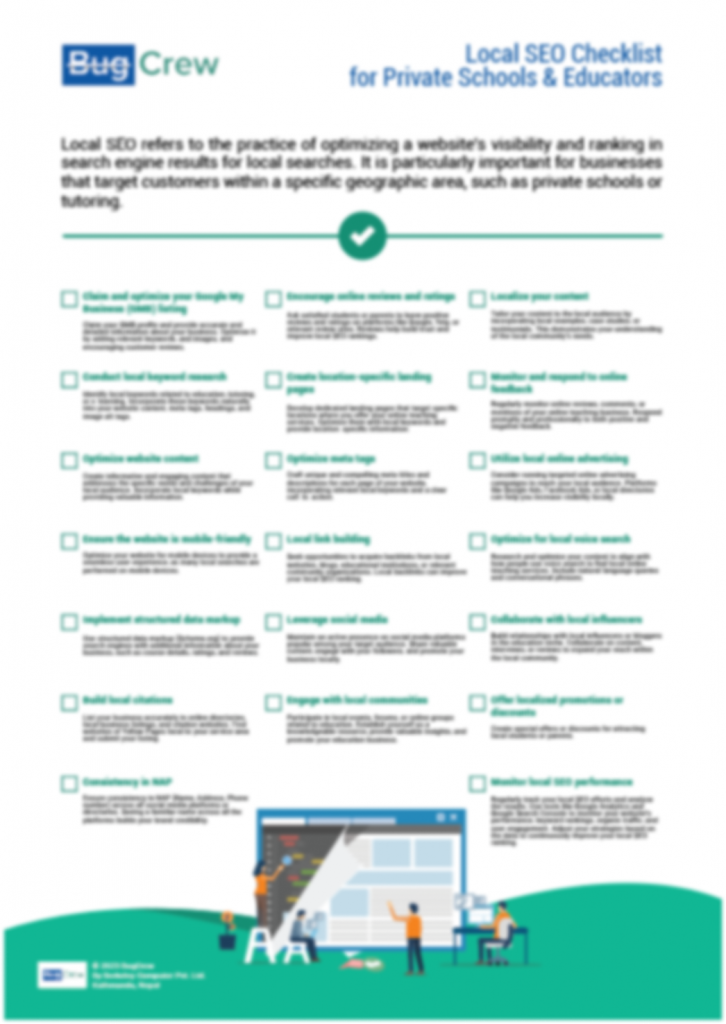Local SEO (Search Engine Optimization) refers to the practice of optimizing a website’s visibility and ranking in search engine results for local searches. It is particularly important for businesses that target customers within a specific geographic area, such as private schools or tutoring
Here’s a checklist for you to get started on optimizing your Local SEO
- Claim and optimize your Google My Business (GMB) listing: Claim your GMB profile and provide accurate and detailed information about your business. Optimize it by adding relevant keywords, and images, and encouraging customer reviews.
- Conduct local keyword research: Identify local keywords related to education, tutoring, or e-learning. Incorporate these keywords naturally into your website content, meta tags, headings, and image alt tags.
- Optimize website content: Create informative and engaging content that addresses the specific needs and challenges of your local audience. Incorporate local keywords while providing valuable information.
- Ensure the website is mobile-friendly: Optimize your website for mobile devices to provide a seamless user experience, as many local searches are performed on mobile devices.
- Implement structured data markup: Use structured data markup (Schema.org) to provide search engines with additional information about your business, such as course details, ratings, and reviews.
- Build local citations: List your business accurately in online directories, local business listings, and citation websites. Find websites of Yellow Pages local to your service area and submit your listing.
- Consistency in NAP: Ensure consistency in NAP (Name, Address, Phone number) across all social media platforms or directories. Seeing a familiar name across all the platforms builds your brand credibility.
- Encourage online reviews and ratings: Ask satisfied students or parents to leave positive reviews and ratings on platforms like Google, Yelp, or relevant review sites. Reviews help build trust and improve local SEO rankings.
- Create location-specific landing pages: Develop dedicated landing pages that target specific locations where you offer your online teaching services. Optimize them with local keywords and provide location-specific information.
- Optimize meta tags: Craft unique and compelling meta titles and descriptions for each page of your website, incorporating relevant local keywords and a clear call-to-action.
- Local link building: Seek opportunities to acquire backlinks from local websites, blogs, educational institutions, or relevant community organizations. Local backlinks can improve your local SEO ranking.
- Leverage social media: Maintain an active presence on social media platforms popular among your target audience. Share valuable content, engage with your followers, and promote your business locally.
- Engage with local communities: Participate in local events, forums, or online groups related to education. Establish yourself as a knowledgeable resource, provide valuable insights, and promote your education business.
- Localize your content: Tailor your content to the local audience by incorporating local examples, case studies, or testimonials. This demonstrates your understanding of the local community’s needs.
- Monitor and respond to online feedback: Regularly monitor online reviews, comments, or mentions of your online teaching business. Respond promptly and professionally to both positive and negative feedback.
- Utilize local online advertising: Consider running targeted online advertising campaigns to reach your local audience. Platforms like Google Ads, Facebook Ads, or local directories can help you increase visibility locally.
- Optimize for local voice search: Research and optimize your content to align with how people use voice search to find local online teaching services. Include natural language queries and conversational phrases.
- Collaborate with local influencers: Build relationships with local influencers or bloggers in the education niche. Collaborate on content, interviews, or reviews to expand your reach within the local community.
- Offer localized promotions or discounts: Create special offers or discounts for attracting local students or parents.
- Monitor local SEO performance: Regularly track your local SEO efforts and analyze the results. Use tools like Google Analytics and Google Search Console to monitor your website’s performance, keyword rankings, organic traffic, and user engagement. Adjust your strategies based on the data to continuously improve your local SEO ranking.
In summary, optimizing your local SEO is crucial for businesses targeting customers within a specific geographic area, such as private schools or tutoring services. By following the checklist provided, you can ensure that your website is well-positioned to attract local traffic and improve your visibility in search engine results. Claim and optimize your Google My Business listing, conduct local keyword research, optimize website content, and ensure mobile-friendliness. Implement structured data markup, build local citations, and encourage online reviews and ratings. Create location-specific landing pages, optimize meta tags, engage in local link building, leverage social media, and engage with local communities. Localize your content, monitor and respond to online feedback, utilize local online advertising, optimize for local voice search, collaborate with local influencers, and offer localized promotions or discounts. Lastly, monitor your local SEO performance using analytics tools and adjust your strategies accordingly. By implementing these tactics, you can enhance your local online presence and attract customers in your target area.
Want to download the 1-Page Checklist PDF? Please submit this form below.


